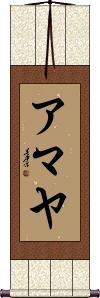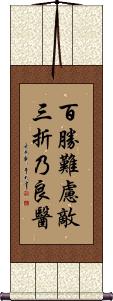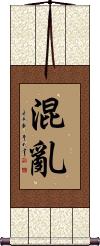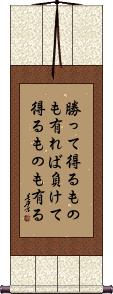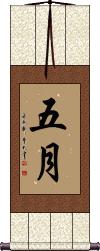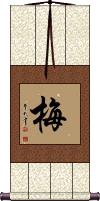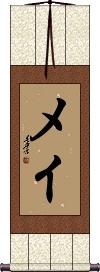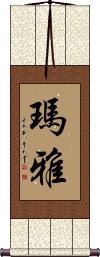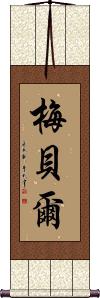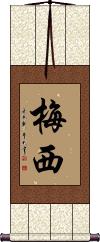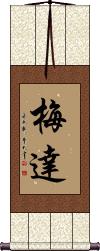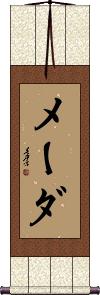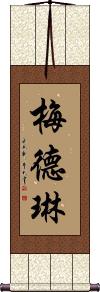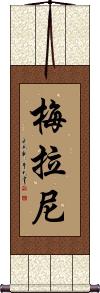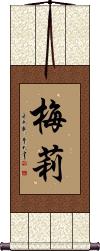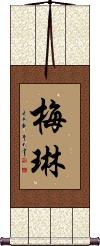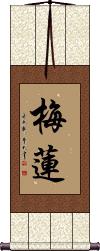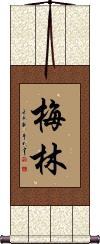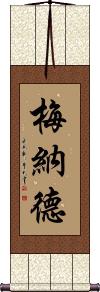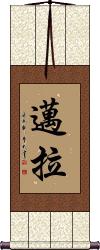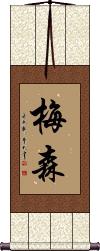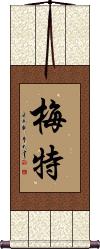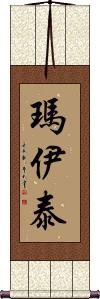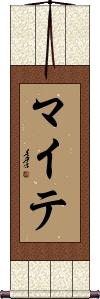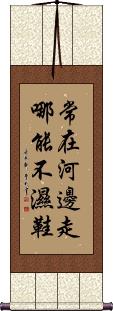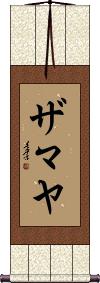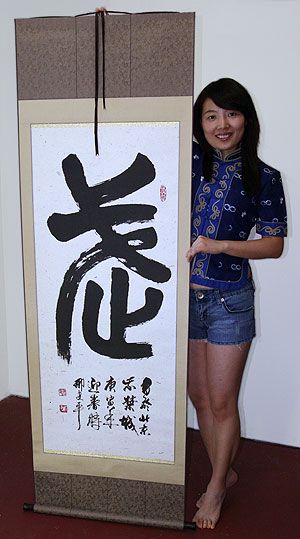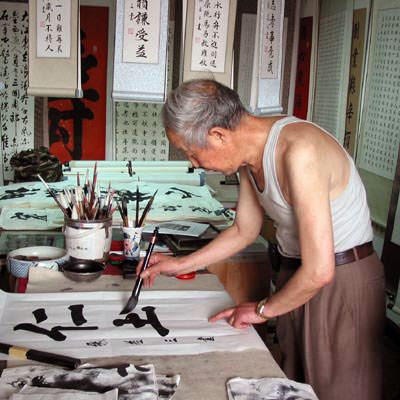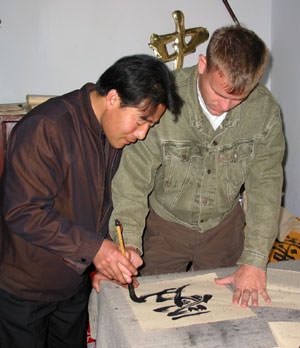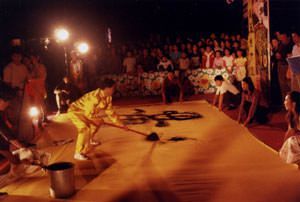The Name May in Japanese/Chinese on a Custom-Made Wall Scroll.
Click the "Customize" button next to your name below to start your personalized may calligraphy artwork...
Switched to secondary search mode due to lack of results using primary.
These secondary results may not be very accurate. Try a different but similar meaning word or phrase for better results. Or...
Look up May in my Japanese Kanji & Chinese Character Dictionary(My dictionary is a different system then the calligraphy search you just tried)
If you want a special phrase, word, title, name, or proverb, feel free to contact me, and I will translate your custom calligraphy idea for you.
1. Even a fool may sometimes come up with a good idea
2. Amaya
3. You May Learn from Victory, You Will Learn from Failure
4. Chaos / Anarchy / Confusion / Mayhem
5. God Bless You / May God Protect You
6. Harimaya
7. Ishmayel
8. Ismay
9. Ismayel
10. You May Learn from Victory, You Will Learn from Failure
11. The Month of May
12. May
13. Maya
14. Maybel
15. Mayci
16. Mayda
17. Maydelyn
18. Mayia
19. Maylani
20. Maylee
21. Mayleen
22. Maylene
23. Maylin
24. Mayliss
25. Maynard
26. Mayotte
27. Mayra
28. Mayson
29. Mayte
30. Montemayor
31. One who walks by the river may end up with wet feet
32. Rumaysa
33. Salomay
34. Zumaya
Even a fool may sometimes come up with a good idea
千慮一得 means “1000 tries, one success,” or “[a] thousand tries [leads to] one success.”
This proverb is a humble way to express your success, ideas, or accomplishments. As if you are a fool who just got lucky in inventing or creating something.
Translations for this proverb include:
Even without any notable ability on my part, I may still get it right sometimes by good luck.
Even a fool may sometimes come up with a good idea.
Compare this to the English idiom, “Even a broken clock is right twice a day.”
Amaya
Amaya
You May Learn from Victory, You Will Learn from Failure
百胜难虑敌三折乃良医 is a Chinese proverb that literally translates as: [Even a general who has won a] hundred victories [may be] hard put to see through the enemy's [strategy], [but one who has] broken [his] arm three [times] [will] be a good doctor.
Figuratively, this means: One cannot always depend on past successes to guarantee future success but one can always learn from lessons drawn from failure.
See Also: Failure - Mother of Success | Experience - Mother of Success | Fall Down 7 Times Get Up 8 | Hard Knocks
Chaos / Anarchy / Confusion / Mayhem
The first character means confused, dirty, muddy, or mixed.
The second character means confusion and disorder.
Together, these characters mean chaos and sometimes extended to mean a type of anarchy.
This term is often used in a less-than-literal term to describe anything in disarray. Someone might use this word in a sentence like, “My kitchen is in a state of chaos” or “my life is so chaotic.”
![]() Please note that Japanese use an alternate/simplified version of the second character of chaos - it also happens to be the same simplification used in mainland China. Click on the character to the right if you want the Japanese/Simplified version of this two-character chaos calligraphy.
Please note that Japanese use an alternate/simplified version of the second character of chaos - it also happens to be the same simplification used in mainland China. Click on the character to the right if you want the Japanese/Simplified version of this two-character chaos calligraphy.
God Bless You / May God Protect You
上帝保佑 is a blessing exchanged between Chinese Christians.
The first two characters mean God (The God of Zion). The second two characters express the idea of giving protection. Another way to translate this is “May God protect you.”
See Also: Guardian Angel
Harimaya
Japanese Surname
Ishmayel
Ishmayel
Ismay
Ismay
Ismayel
Ismayel
You May Learn from Victory, You Will Learn from Failure
You may learn when everything goes right but the lessons learned when everything goes wrong are more vivid and lead to long-lasting wisdom.
Another way to look at this: One cannot always depend on past successes to guarantee future success but one can always learn from lessons drawn from failure.
Note: Because this selection contains some special Japanese Hiragana characters, it should be written by a Japanese calligrapher.
The Month of May
Fifth Month
五月 is the month of May in Chinese, Japanese Kanji, and old Korean Hanja.
This was originally the fifth month of the Chinese lunar year, now used for the fifth month of the Gregorian calendar (also known as the Western or Christian calendar). 五月 literally means “fifth month” or “fifth moon.”
Note: Sometimes Japanese parents will use this as a female given name, and use "Mei" (the sound of May in English) as the pronunciation.
This is a common transliteration to Mandarin Chinese for the name May.
梅 actually means “plum blossom.” This is a common name for girls in China.
Maya
Maya
Maybel
Maybel
Mayci
Mayci
Mayda
Mayda
Maydelyn
Maydelyn
Mayia
Maylani
Maylani
Maylee
Maylee
Mayleen
Mayleen
Maylene
Maylene
Maylin
Maylin
Mayliss
Mayliss
Maynard
Maynard
Mayotte
Mayotte
Mayra
Mayra
Mayson
Mayson
Mayte
Mayte
Mayte
Montemayor
Montemayor
One who walks by the river may end up with wet feet
常在河邊走哪能不濕鞋 is an old Chinese proverb that is sometimes compared to the English saying “Shit Happens.”
It's a reflection that there are risks in life, and you should not be surprised when things don't go your way.
A secondary translation might be, “When walking by a river, often one cannot avoid wet shoes.”
Rumaysa
Rumaysa
Salomay
Salomay
Zumaya
Zumaya
The following table may be helpful for those studying Chinese or Japanese...
| Title | Characters | Romaji (Romanized Japanese) | Various forms of Romanized Chinese | |
| Even a fool may sometimes come up with a good idea | 千慮一得 千虑一得 | senryonoittoku | qiān lǜ yī dé qian1 lv4 yi1 de2 qian lv yi de qianlvyide | ch`ien lü i te chienlüite chien lü i te |
| Amaya | 阿馬亞 阿马亚 | ā mǎ yà / a1 ma3 ya4 / a ma ya / amaya | ||
| Amaya | アマヤ | amaya | ||
| You May Learn from Victory, You Will Learn from Failure | 百勝難慮敵三折乃良醫 百胜难虑敌三折乃良医 | bǎi shèng nán lǜ dí sān zhé nǎi liáng yī bai3 sheng4 nan2 lv4 di2 san1 zhe2 nai3 liang2 yi1 bai sheng nan lv di san zhe nai liang yi | pai sheng nan lü ti san che nai liang i | |
| Chaos Anarchy Confusion Mayhem | 混亂 混乱 | kon ran / konran | hùn luàn / hun4 luan4 / hun luan / hunluan | |
| God Bless You May God Protect You | 上帝保佑 | shàng dì bǎo yòu shang4 di4 bao3 you4 shang di bao you shangdibaoyou | shang ti pao yu shangtipaoyu |
|
| Harimaya | 播磨屋 | harimaya | ||
| Ishmayel | 伊斯梅爾 伊斯梅尔 | yī sī méi ěr yi1 si1 mei2 er3 yi si mei er yisimeier | i ssu mei erh issumeierh |
|
| Ishmayel | イシュマイエル | ishumaieru | ||
| Ismay | 伊斯梅 | yī sī méi yi1 si1 mei2 yi si mei yisimei | i ssu mei issumei |
|
| Ismay | イスメイ | isumei | ||
| Ismayel | 伊斯梅爾 伊斯梅尔 | yī sī méi ěr yi1 si1 mei2 er3 yi si mei er yisimeier | i ssu mei erh issumeierh |
|
| Ismayel | イスマイエル | isumaieru | ||
| You May Learn from Victory, You Will Learn from Failure | 勝って得るものも有れば負けて得るものも有る | katte erumono mo areba makete erumono mo aru | ||
| The Month of May | 五月 | satsuki / go gatsu satsuki / gogatsu | wǔ yuè / wu3 yue4 / wu yue / wuyue | wu yüeh / wuyüeh |
| May | 梅 | méi / mei2 / mei | ||
| May | メイ | mei | ||
| Maya | 瑪雅 玛雅 | mǎ yǎ / ma3 ya3 / ma ya / maya | ||
| Maya | マイヤ | maiya | ||
| Maybel | 梅貝爾 梅贝尔 | méi bèi ěr mei2 bei4 er3 mei bei er meibeier | mei pei erh meipeierh |
|
| Maybel | メーベル | meeberu / meberu | ||
| Mayci | 梅西 | méi xī / mei2 xi1 / mei xi / meixi | mei hsi / meihsi | |
| Mayci | メイシー | meishii / meishi | ||
| Mayda | 梅達 梅达 | méi dá / mei2 da2 / mei da / meida | mei ta / meita | |
| Mayda | メーダ | meeda / meda | ||
| Maydelyn | 梅德琳 | méi dé lín mei2 de2 lin2 mei de lin meidelin | mei te lin meitelin |
|
| Maydelyn | メイデリン | meiderin | ||
| Mayia | メイヤ | meiya | ||
| Maylani | 梅拉尼 | méi lā ní mei2 la1 ni2 mei la ni meilani | ||
| Maylani | メイラニ | meirani | ||
| Maylee | 梅莉 | méi lì / mei2 li4 / mei li / meili | ||
| Maylee | メーリー | meerii / meri | ||
| Mayleen | 梅琳 | méi lín / mei2 lin2 / mei lin / meilin | ||
| Mayleen | メーリーン | meeriin / merin | ||
| Maylene | 梅蓮 梅莲 | méi lián / mei2 lian2 / mei lian / meilian | mei lien / meilien | |
| Maylene | メーリーン | meeriin / merin | ||
| Maylin | 梅林 | méi lín / mei2 lin2 / mei lin / meilin | ||
| Maylin | メイリン | meirin | ||
| Mayliss | 瑪伊莉絲 玛伊莉丝 | mǎ yī lì sī ma3 yi1 li4 si1 ma yi li si mayilisi | ma i li ssu mailissu |
|
| Mayliss | メーリス | meerisu / merisu | ||
| Maynard | 梅納德 梅纳德 | méi nà dé mei2 na4 de2 mei na de meinade | mei na te meinate |
|
| Maynard | メイナード | meinaado / meinado | ||
| Mayotte | 馬約特 马约特 | mǎ yuē tè ma3 yue1 te4 ma yue te mayuete | ma yüeh t`e mayüehte ma yüeh te |
|
| Mayotte | マヨット | mayotto | ||
| Mayra | 邁拉 迈拉 | mài lā / mai4 la1 / mai la / maila | ||
| Mayra | マイラ | maira | ||
| Mayson | 梅森 | méi sēn / mei2 sen1 / mei sen / meisen | ||
| Mayson | メイソン | meison | ||
| Mayte | 梅特 | méi tè / mei2 te4 / mei te / meite | mei t`e / meite / mei te | |
| Mayte | 瑪伊泰 玛伊泰 | mǎ yī tài ma3 yi1 tai4 ma yi tai mayitai | ma i t`ai maitai ma i tai |
|
| Mayte | マイテ | maite | ||
| Montemayor | 蒙特馬約爾 蒙特马约尔 | méng tè mǎ yuē ěr meng2 te4 ma3 yue1 er3 meng te ma yue er mengtemayueer | meng t`e ma yüeh erh mengtemayüeherh meng te ma yüeh erh |
|
| Montemayor | モンテマヨール | montemayooru montemayoru | ||
| One who walks by the river may end up with wet feet | 常在河邊走哪能不濕鞋 常在河边走哪能不湿鞋 | cháng zài hé biān zǒu nǎ néng bù shī xié chang2 zai4 he2 bian1 zou3 na3 neng2 bu4 shi1 xie2 chang zai he bian zou na neng bu shi xie | ch`ang tsai ho pien tsou na neng pu shih hsieh chang tsai ho pien tsou na neng pu shih hsieh |
|
| Rumaysa | 魯邁薩 鲁迈萨 | lǔ mài sà lu3 mai4 sa4 lu mai sa lumaisa | ||
| Rumaysa | ルマイサ | rumaisa | ||
| Salomay | 莎樂美 莎乐美 | shā lè měi sha1 le4 mei3 sha le mei shalemei | ||
| Salomay | セーロメー | seeromee / serome | ||
| Zumaya | 祖瑪雅 祖玛雅 | zǔ mǎ yǎ zu3 ma3 ya3 zu ma ya zumaya | tsu ma ya tsumaya |
|
| Zumaya | ザマヤ | zamaya | ||
| In some entries above you will see that characters have different versions above and below a line. In these cases, the characters above the line are Traditional Chinese, while the ones below are Simplified Chinese. | ||||


